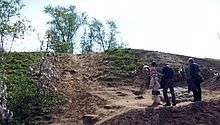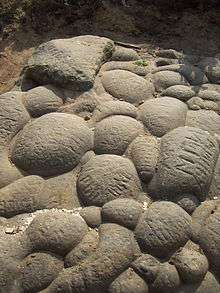Golosov Ravine
Golosov Ravine (Голосов Овраг), also known as Vlasov (Власов) ravine[1] is a deep ravine in Moscow, Russia, between the Kolomenskoe Hill and Dyakovo Hill. The ravine has several springs and a brook streaming at its bottom. Up in the ravine, on the left side of it, there is a Neopagan shrine, organized around two venerated "sacred stones". In years 2006–2007, during the renovation of Kolomenskoe sides of the ravine were reinforced, and pedestrian paths and stairs were created on its sides.

History
Since ancient times this ravine has always been a bit of a mystery. Inexplicable things constantly happened here in the past. For example, one amazing story was described in the 17th-century sources. In 1621, a small detachment of Tatar horsemen turned up at the walls of the Tsar's palace in Kolomna. They were surrounded and captured immediately by the warriors, who guarded the entrance to the palace. Being lost and disoriented, they claimed to be part of the armies of the Crimean khan Devlet I Giray that had attacked Moscow in 1571. Sensing defeat and wanting to avoid capture, they retreated into Golosov ravine, where they were quickly enveloped in a thick mist. Spending what seemed like only a few minutes finding their way through the fog, they emerged to find that 50 years had already passed. One of the captives, named Murza, said that the mist was unusual, of light green colour, but none of them paid attention to it, due to fear of the chasing. Tsar Mikhail Fedorovich ordered to undertake an inquiry, which showed that the men “probably told the truth.” They had even old-fashioned armor and ammunition, mostly of 1560s or 1570s types.[2]
This wasn't the only reported incident of time travel in the surroundings of Golosov Ravine. In the 19th century, such cases were documented by the Moscow province's police office. One story was published in the newspaper “Moscovkie vedomosti” in July 1832. Two local peasants, Arhip Kuzmin and Ivan Botchkarev, had a big night out at a neighboring village and decided to take a shortcut through the ravine on their way home. There was the same thick green mist that filled the ravine, where a strange corridor suddenly appeared. The peasants stepped down into it and met large and hairy manlike creatures, who managed to put them back on the right path via hand signals. A few minutes later, the peasants left the ravine and continued their way. When they eventually came to their native village, it turned out that two decades had already passed. Their wives and children did not recognize them. The incident was reported to the police who conducted an investigation, during which one of the men dissolved into the fog and never returned.
Down through the centuries, people have been periodically seen hairy human-resembling creatures round Golosov ravine. Such cases were mentioned not only in the ancient and medieval chronicles, but also in the Soviet periodical press. Large hairy manlike creatures most likely represent the leshy - a sort of bigfoot from Slavic mythology, who is more man than ape and more woodland spirit than mortal creature. In 1926, a policeman reported seeing a “hairy wild man” over two meters tall (6.6 ft) in Golosov Ravine. The policeman pulled out his pistol, but the strange creature instantly dissolved in the fog. Local schoolchildren joined the search for the unusual guest, but they were unable to detect his traces. However, one of the official Moscow newspapers published the article “Young Pioneers (Soviet Boy Scouts) are capturing a leshy”, by the journalist A.Ryazantsev.
The sacred stones
The "sacred stones of Kolomenskoe" are a pair of local sandstone[3] rocks of peculiar shape, located high in the ravine. Some sources claim them to be granite boulders of glacial origin,[4] but this seems to be a misconception. Both rocks have traces of manual processing, both old (exaggerating the shape of the stones), and new (as they have been vandalized by modern graffiti). Initially the stones were located further down the ravine, closer to the springs, but during one of the renovations of the park in the Soviet era they were dragged to the place where they reside now.
The ancient shrine of Veles
According to a recently popularized theory, Golosov Ravine might have initially hosted a shrine dedicated to the Slavic deity Veles.[5] The name of Veles is said to be traceable in modern name of the ravine (Golosov or Vlasov, through Volosov, from Velesov).[6] The shrine might have been later Christianized, with the stones re-interepreted by local inhabitants as traces of a famous battle between St. George (the patron saint of Moscow) and the dragon,[4][7] thus preserving the ancient mythological motif under new names (see "Enemy of Perun and storm myth" section in Veles article).
Modern veneration practices
The stones have their own names: one is called Deviy (or Devichiy, Russian: Девий, Девичий, meaning "Virgin"), and is associated by modern worshipers with giving fertility to women,[8] while the other one is called Gus’ (Гусь, meaning "Goose"). Local lore tells that they help to cure certain diseases, so people come and sit by them,[9][10] and also tie small pieces of tissue onto nearby trees.[11]
History of the veneration
According to some sources, the stones were not continuously venerated by locals in the 20th century, which would mean that the tradition is discontinuous, and may not follow the older patterns, whatever they might have been.[3]
Springs
The nearby springs are also considered sacred (miracle-bearing) in contemporary Eastern Orthodoxy,[12] Neopagan[13] and New-Age[14][15] traditions. Before the Revolution of 1917 there was a wooden chapel standing on top of (or near?) the springs,[4] which implies that the springs were considered "sacred" or "holy" in the past as well. Several springs have (or had) their own names: Kadochka (literally: "Little Tub"; seemingly the most venerated one,[12] with its sub-springs associated with St. George and Our Lady of Kazan[3]); Peter and Paul's spring; the spring of the 12 apostles; St. Nicholas spring.[3] Some of these springs were destroyed during the recent renovation works in the ravine.[3]

References
- Data from «Улицы Москвы. Старые и новые названия». М., ИЦ «Наука,техника,образование», 2003 (Russian)
- http://www.gazetanv.ru/article/?id=167
- Ю.Насимович. РЕКИ, ОЗЁРА И ПРУДЫ МОСКВЫ (in Russian)
- History of the ravine at archnadzor.ru (in Russian)
- Коломенское обращение КО ВСЕМ ЯЗЫЧЕСКИМ ОБЩИНАМ РОССИИ И БЛИЖНЕГО ЗАРУБЕЖЬЯ Archived 2012-03-28 at the Wayback Machine at "Свет Сварога" (Russian)
- On the relation between the name Vlas and pagan god Veles (in Russian)
- Project "Каширская Дорога" (Russian)
- Detailed description of actions that are expected from stone worshipers (Russian)
- Description of modern practices associated with the stone (Russian)
- Pictures of the veneration (Russian)
- К. Гусев. "Москвичи рискуют провалиться во времени". Комсомольская Правда 03.07.2005 (Russian)
- Чудотворные православные источники России
- Голосов Овраг at lvovich.ru (Russian)
- «Девичий камень» и «Гусь камень» в Коломенском at hotimdetey.ru (Russian)
- Совсем не про Коломенское - a comprehensive set of modern urban legends about Golosov Ravine (in Russian)